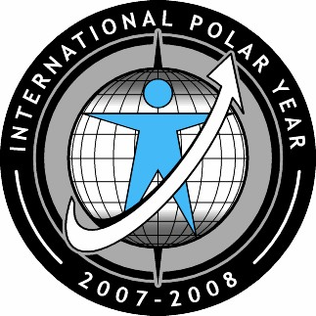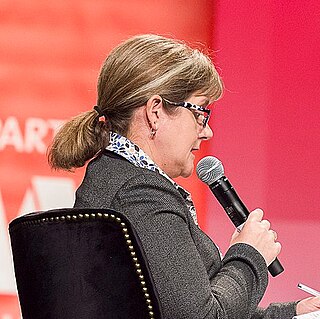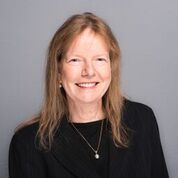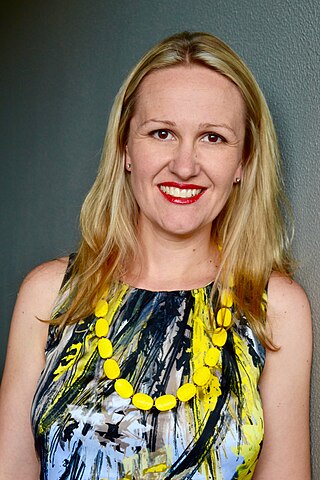
The International Polar Years (IPY) are collaborative, international efforts with intensive research focus on the polar regions. Karl Weyprecht, an Austro-Hungarian naval officer, motivated the endeavor in 1875, but died before it first occurred in 1882–1883. Fifty years later (1932–1933) a second IPY took place. The International Geophysical Year was inspired by the IPY and was organized 75 years after the first IPY (1957–58). The fourth, and most recent, IPY covered two full annual cycles from March 2007 to March 2009.

Casey Station, commonly called Casey, is one of three permanent stations and research outposts in Antarctica managed by the Australian Antarctic Division (AAD). Casey lies on the northern side of the Bailey Peninsula overlooking Vincennes Bay on the Budd Coast of Wilkes Land in the Australian Antarctic Territory, a territory claimed by Australia. Casey is 3,880 kilometres (2,410 mi) due south of Perth, Western Australia.
The Bureau of Meteorology is an executive agency of the Australian Government responsible for providing weather services to Australia and surrounding areas. It was established in 1906 under the Meteorology Act, and brought together the state meteorological services that existed before then. The states officially transferred their weather recording responsibilities to the Bureau of Meteorology on 1 January 1908.

The Philippine Atmospheric, Geophysical and Astronomical Services Administration is the National Meteorological and Hydrological Services (NMHS) agency of the Philippines mandated to provide protection against natural calamities and to ensure the safety, well-being and economic security of all the people, and for the promotion of national progress by undertaking scientific and technological services in meteorology, hydrology, climatology, astronomy and other geophysical sciences. Created on December 8, 1972, by reorganizing the Weather Bureau, PAGASA now serves as one of the Scientific and Technological Services Institutes of the Department of Science and Technology.
Science & Technology Australia (STA), formerly known as the Federation of Australian Scientific and Technological Societies (FASTS), is an organisation representing the interests of more than 90,000 Australian scientists and technologists, and promoting their views on a wide range of policy issues to the Australian Government, Australian industry, and the Australian community.

Lisa Harvey-Smith is a British-Australian astrophysicist, Australia's Women in STEM Ambassador and a Professor of Practice in Science Communication at the University of NSW. Her research interests include the origin and evolution of cosmic magnetism, supernova remnants, the interstellar medium, massive star formation and astrophysical masers. For almost a decade Harvey-Smith was a research scientist at Australia’s Commonwealth Scientific and Industrial Research Organisation (CSIRO), including several years as the Project Scientist for the Square Kilometre Array Pathfinder and later Project Scientist for the Australian Square Kilometre Array Pathfinder (ASKAP) Telescope.
Julie Michelle Arblaster is an Australian scientist. She is a Professor in the School of Earth, Atmosphere and Environment at Monash University. She was a contributing author on reports for which the Intergovernmental Panel on Climate Change (IPCC) was a co-recipient of the 2007 Nobel Peace Prize. Arblaster was a lead author on Chapter 12 of the IPCC Working Group I contribution to the IPCC Fifth Assessment Report in 2013. She has received the 2014 Anton Hales Medal for research in earth sciences from the Australian Academy of Science, and the 2017 Priestley Medal from the Australian Meteorological and Oceanographic Society. She has been ranked as one of the Top Influential Earth Scientists of 2010-2020, based on citations and discussion of her work.
Madhu Bhaskaran is an engineer and Professor at RMIT University. She co-leads the Functional Materials and Microsystems Research Group at RMIT University She won the APEC Aspire prize in 2018 for her development of "electronic skin".

Marguerite Virginia Evans-Galea is the co-founder of Women in STEMM Australia. STEMM. Her research is focused on gene therapy and neurodegenerative diseases.
Caroline E. Ford is an Australian scientist at the University of New South Wales and advocate for women in science. Her research aims to understand why gynaecological cancers develop, how they spread and how best to treat them, and she leads the Gynaecological Cancer Research Group at the University of New South Wales, which was established in 2010.

Melina Georgousakis is the founder of Franklin Women, an Australian organisation for women working in health and medical careers. She won a Eureka Prize in 2021.
Muireann Irish is a cognitive neuropsychologist at the Brain and Mind Centre at the University of Sydney. She has won international and national awards, including an Australian Research Council Future Fellowship and L’Oreal-UNESCO For Women in Science Fellowship.

Leonie Walsh is a fellow of the Australian Academy of Technological Sciences, and was the first Lead Scientist in Victoria, from 2013 to 2016, as well as the inaugural Women in STEMM Ambassador and the first women president of Australasian Industrial Research Group She was the representative for Victoria on the Forum of Australian Chief Scientists. Walsh received an honorary Doctorate (HonDUniv) due to her contributions in leadership to scientific enterprises, innovation and community leadership, from Swinburne University of Technology. Walsh was a judge in the Westpac 100 Women of Influence awards in 2016.
Christine Susan Betham Grimmond is a New Zealand scientist and professor of urban meteorology at the University of Reading. She currently holds the post of Met Office Joint Chair. Grimmond is a pioneer of the fields of urban meteorology and micrometerology, which deal with the atmospheric boundary layer.
Elaine Saunders is an associate professor at the Swinburne University of Technology and executive director of Blamey Saunders, as well as an inventor, entrepreneur. She was elected a Fellow of the Australian Academy of Science Technology and Engineering in 2019. She is one of only nine women out of 160 to win the Clunies Ross award for entrepreneurship, and has won many other awards, as well as given numerous keynote addresses on the value of entrepreneurship and innovation in STEMM.

Jessica Geraldine Borger is an Australian T Cell immunologist, lecturer and graduate course coordinator at the Central Clinical School, Monash University. Her research has added to the understanding of the molecular mechanisms of T cell function. Additionally, Borger is a news and commentary editor for Immunology & Cell Biology and a guest associate editor for Frontiers in Immunology, and a reviewer for several academic journals. Jessica also advocates for gender equality in science, technology, engineering and mathematics (STEM) in her position a member of the Gender Equity, Diversity and Inclusion committee of the Central Clinical School at Monash University.
Carolina Susana Vera is an Argentine meteorologist. She is the principal investigator of the Argentine research council National Scientific and Technical Research Council (CONICET), and a professor at the Faculty of Exact and Natural Sciences at the University of Buenos Aires (UBA). Her research focuses on climate variability and global warming in South America.
Denise Allen is a Meteorology Observer and Forecaster who worked with the Bureau of Meteorology.
Marlene Kanga is an Australian engineer, entrepreneur, and diversity activist, who was awarded Queens Birthday honours in 2022. She was appointed an officer of the Order of Australia for her substantial service to Engineering, particularly as a global leader and role model to women to professional organisations, and to business.
Chamindie Punyadeera FTSE is a researcher at Griffith University who was selected to be a Fellow of the Australian Academy of Technology, Science and Engineering in 2023. She is a researcher in cancer and heart disease, leading a team who uses human saliva and blood as diagnostic tools for detecting heart disease and cancer early.








